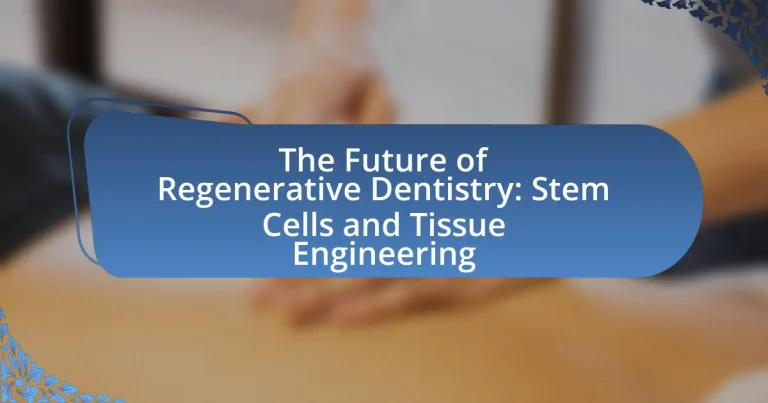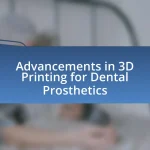The article focuses on the future of regenerative dentistry, emphasizing the role of stem cells and tissue engineering in transforming dental care. It outlines how advancements in these fields can enable the regeneration of dental tissues such as enamel, dentin, and pulp, potentially reducing reliance on traditional restorative procedures. Key principles of regenerative dentistry, including the use of stem cells, bioactive scaffolds, and 3D bioprinting, are discussed, along with the importance of patient selection and the challenges faced in this evolving field. The article also highlights emerging trends, potential breakthroughs, and the significance of continuing education for dental professionals to stay updated on advancements in regenerative techniques.
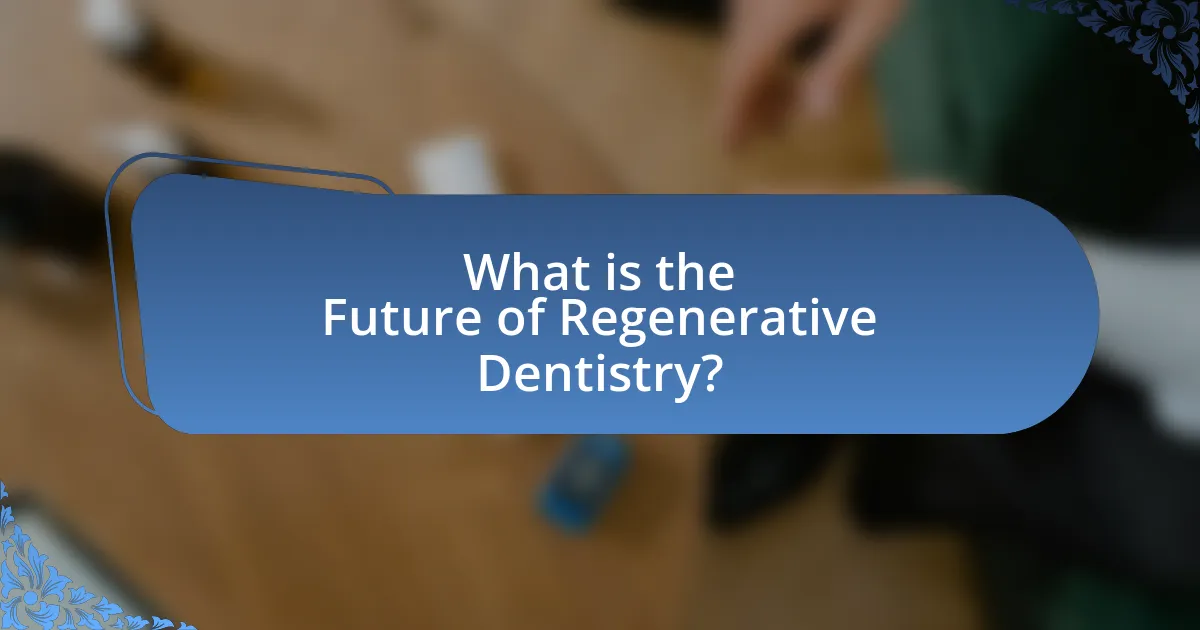
What is the Future of Regenerative Dentistry?
The future of regenerative dentistry is poised to significantly enhance dental care through advancements in stem cell research and tissue engineering. Innovations in these fields are expected to enable the regeneration of dental tissues, such as enamel, dentin, and pulp, potentially eliminating the need for traditional restorative procedures like fillings and crowns. Research indicates that stem cells derived from dental pulp can differentiate into various cell types necessary for tissue regeneration, as demonstrated in studies published in journals like “Stem Cells Translational Medicine.” Furthermore, the integration of 3D bioprinting technology is anticipated to facilitate the precise fabrication of dental tissues, improving the success rates of regenerative treatments. These developments suggest a transformative shift in how dental professionals approach tooth repair and regeneration, ultimately leading to more effective and less invasive treatment options for patients.
How does regenerative dentistry differ from traditional dentistry?
Regenerative dentistry differs from traditional dentistry primarily in its focus on repairing and regenerating dental tissues rather than merely restoring them. Traditional dentistry typically involves procedures like fillings, crowns, and extractions that address symptoms and damage without restoring the original biological structure. In contrast, regenerative dentistry employs techniques such as stem cell therapy and tissue engineering to promote the natural healing and regeneration of dental tissues, aiming for a more holistic and long-lasting solution. For instance, studies have shown that stem cells derived from dental pulp can differentiate into various cell types, facilitating the regeneration of dentin and pulp tissues, which is a significant advancement over conventional methods that do not utilize biological regeneration.
What are the key principles of regenerative dentistry?
The key principles of regenerative dentistry include the use of stem cells, tissue engineering, and biomaterials to restore dental tissues and structures. Stem cells are pivotal as they possess the ability to differentiate into various cell types necessary for dental regeneration. Tissue engineering combines these stem cells with scaffolds and growth factors to create a conducive environment for tissue repair and regeneration. Additionally, the application of biomaterials is essential for supporting cell attachment and promoting healing. These principles are supported by research indicating that regenerative approaches can effectively restore lost dental structures, as demonstrated in studies published in journals such as “Tissue Engineering” and “Journal of Dental Research.”
Why is regenerative dentistry gaining importance in modern healthcare?
Regenerative dentistry is gaining importance in modern healthcare due to its potential to restore dental tissues and improve patient outcomes. This field utilizes advanced techniques such as stem cell therapy and tissue engineering to regenerate damaged or lost dental structures, addressing issues like tooth decay and periodontal disease more effectively than traditional methods. Research indicates that regenerative approaches can lead to better functional and aesthetic results, with studies showing that stem cell-based therapies can promote healing and regeneration in dental tissues, thereby reducing the need for invasive procedures.
What role do stem cells play in regenerative dentistry?
Stem cells play a crucial role in regenerative dentistry by providing the ability to regenerate dental tissues, such as pulp, dentin, and periodontal structures. These cells possess the unique capability to differentiate into various cell types necessary for tissue repair and regeneration, which is essential for treating dental diseases and injuries. Research has demonstrated that stem cells derived from dental tissues, such as dental pulp stem cells and periodontal ligament stem cells, can effectively promote healing and regeneration in dental applications. For instance, studies have shown that these stem cells can enhance the formation of new dentin and support the regeneration of periodontal tissues, thereby improving outcomes in dental treatments.
What types of stem cells are used in dental applications?
Mesenchymal stem cells (MSCs) and dental pulp stem cells (DPSCs) are the primary types of stem cells used in dental applications. MSCs, derived from various tissues such as bone marrow and adipose tissue, have the ability to differentiate into multiple cell types, making them valuable for regenerative procedures. DPSCs, specifically isolated from the dental pulp of human teeth, possess unique properties that enable them to regenerate dental tissues and support tooth repair. Research has demonstrated that DPSCs can effectively differentiate into odontoblast-like cells, contributing to dentin formation, which is crucial for dental tissue engineering.
How are stem cells sourced for regenerative dental treatments?
Stem cells for regenerative dental treatments are primarily sourced from dental tissues, such as dental pulp, periodontal ligament, and exfoliated deciduous teeth. Dental pulp stem cells, found within the soft tissue of teeth, are particularly valuable due to their ability to differentiate into various cell types and promote tissue regeneration. Research indicates that these stem cells can be easily harvested during routine dental procedures, making them a practical option for regenerative therapies. Studies have shown that dental pulp stem cells possess similar properties to mesenchymal stem cells, which are widely recognized for their regenerative capabilities, thus validating their use in dental applications.
What advancements are being made in tissue engineering for dentistry?
Advancements in tissue engineering for dentistry include the development of bioactive scaffolds, stem cell therapies, and 3D bioprinting techniques. Bioactive scaffolds, which are designed to mimic the natural extracellular matrix, enhance cell attachment and proliferation, facilitating tissue regeneration. Stem cell therapies utilize dental pulp stem cells and other sources to promote healing and regeneration of dental tissues, showing promising results in clinical applications. Additionally, 3D bioprinting allows for the precise fabrication of dental tissues, enabling the creation of customized implants and regenerative solutions. These advancements are supported by research demonstrating improved outcomes in tissue regeneration and integration, highlighting their potential in future dental treatments.
What materials are commonly used in dental tissue engineering?
Common materials used in dental tissue engineering include hydrogels, ceramics, and polymers. Hydrogels, such as alginate and gelatin, provide a supportive environment for cell growth and tissue formation due to their high water content and biocompatibility. Ceramics, like hydroxyapatite and tricalcium phosphate, are utilized for their osteoconductive properties, promoting bone regeneration. Polymers, including polylactic acid and polycaprolactone, are favored for their mechanical properties and ability to be tailored for specific applications in tissue scaffolding. These materials have been validated through various studies demonstrating their effectiveness in supporting dental tissue regeneration and integration with host tissues.
How do these materials support tissue regeneration?
Materials used in regenerative dentistry, such as hydrogels, scaffolds, and bioactive ceramics, support tissue regeneration by providing a conducive environment for cell attachment, proliferation, and differentiation. These materials mimic the extracellular matrix, facilitating the natural healing processes by releasing growth factors and promoting angiogenesis. For instance, studies have shown that hydrogels can enhance stem cell viability and function, leading to improved tissue repair outcomes. Additionally, bioactive ceramics have been demonstrated to stimulate osteogenic differentiation, which is crucial for bone regeneration.
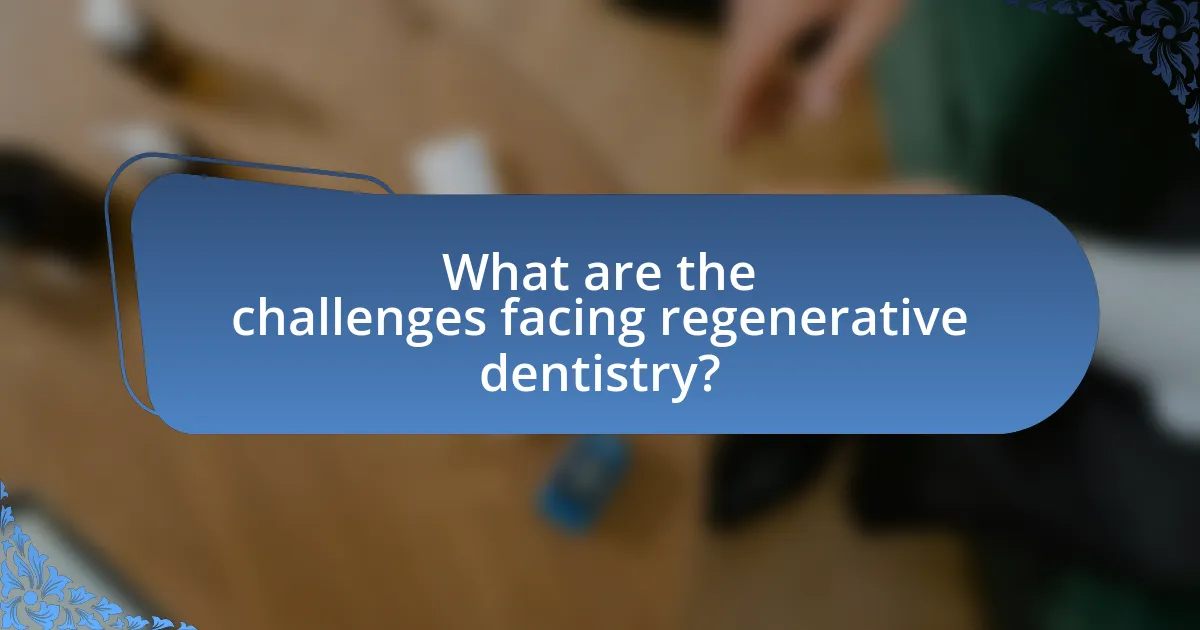
What are the challenges facing regenerative dentistry?
Regenerative dentistry faces several challenges, including the complexity of tissue regeneration, the need for biocompatible materials, and regulatory hurdles. The complexity arises from the intricate structure and function of dental tissues, which makes it difficult to replicate them accurately. Additionally, finding materials that are both biocompatible and capable of supporting cell growth is essential for successful outcomes. Regulatory hurdles also pose significant challenges, as the approval processes for new regenerative therapies can be lengthy and complicated, often delaying advancements in the field.
What ethical considerations are involved in stem cell research?
Ethical considerations in stem cell research primarily revolve around the moral status of embryos, informed consent, and potential exploitation. The debate centers on whether human embryos, often used in research, possess rights and should be afforded moral consideration. Informed consent is crucial, as donors must fully understand the implications of their contributions. Additionally, there is concern about the potential for exploitation of vulnerable populations in obtaining stem cells. These considerations are underscored by guidelines from organizations like the National Institutes of Health, which emphasize ethical standards in research practices.
How do regulations impact the development of regenerative dental therapies?
Regulations significantly impact the development of regenerative dental therapies by establishing safety and efficacy standards that must be met before therapies can be approved for clinical use. These regulations, enforced by agencies such as the U.S. Food and Drug Administration (FDA), require extensive preclinical and clinical testing to ensure that new therapies do not pose risks to patients. For instance, the FDA’s guidance on the use of stem cells in regenerative medicine mandates that products derived from human cells must demonstrate both safety and effectiveness through rigorous trials, which can prolong the development timeline and increase costs. Consequently, while regulations are essential for patient safety, they can also create barriers that slow innovation and limit the availability of new regenerative dental therapies.
What are the potential risks associated with stem cell treatments?
Potential risks associated with stem cell treatments include infection, immune rejection, and tumor formation. Infection can occur at the site of injection or during the harvesting process, leading to complications. Immune rejection happens when the recipient’s body identifies the stem cells as foreign, potentially causing adverse reactions. Tumor formation is a significant concern, as improperly differentiated stem cells can lead to uncontrolled cell growth, resulting in cancer. Studies have shown that these risks are not negligible; for instance, a review published in the journal “Nature” highlighted that approximately 5-10% of patients experienced complications related to stem cell therapies.
How can we improve the effectiveness of regenerative dental procedures?
To improve the effectiveness of regenerative dental procedures, integrating advanced biomaterials and stem cell therapies is essential. Research indicates that the use of biocompatible scaffolds can enhance cell attachment and proliferation, leading to better tissue regeneration outcomes. For instance, a study published in the journal “Tissue Engineering” by Zhang et al. (2020) demonstrated that a composite scaffold significantly improved the regeneration of dental pulp tissue in animal models. Additionally, optimizing the delivery methods of stem cells, such as using hydrogels, can further enhance their survival and functionality at the site of injury, as evidenced by findings in “Stem Cells Translational Medicine” by Liu et al. (2019). These strategies collectively contribute to more effective regenerative dental procedures.
What role does patient selection play in treatment outcomes?
Patient selection is critical in determining treatment outcomes in regenerative dentistry, particularly when utilizing stem cells and tissue engineering. Appropriate patient selection ensures that individuals with the best potential for positive responses to treatment are chosen, which can significantly enhance the effectiveness of regenerative procedures. Studies have shown that factors such as age, overall health, and specific dental conditions can influence the success rates of treatments involving stem cells. For instance, younger patients often exhibit better healing responses due to more robust biological processes, while patients with certain systemic diseases may face complications that hinder treatment efficacy. Therefore, careful evaluation of these factors during patient selection directly correlates with improved treatment outcomes in regenerative dentistry.
How can technology enhance regenerative dentistry practices?
Technology can enhance regenerative dentistry practices by enabling advanced techniques such as 3D bioprinting, stem cell therapy, and digital imaging. These innovations allow for precise tissue engineering, where 3D bioprinting can create scaffolds that mimic natural tooth structures, facilitating the regeneration of dental tissues. Additionally, stem cell therapy harnesses the regenerative potential of stem cells to repair or replace damaged dental tissues, improving healing outcomes. Digital imaging technologies, such as cone beam computed tomography (CBCT), provide detailed visualization of dental structures, aiding in treatment planning and monitoring the success of regenerative procedures. These technological advancements collectively improve the efficacy and efficiency of regenerative dentistry, leading to better patient outcomes.
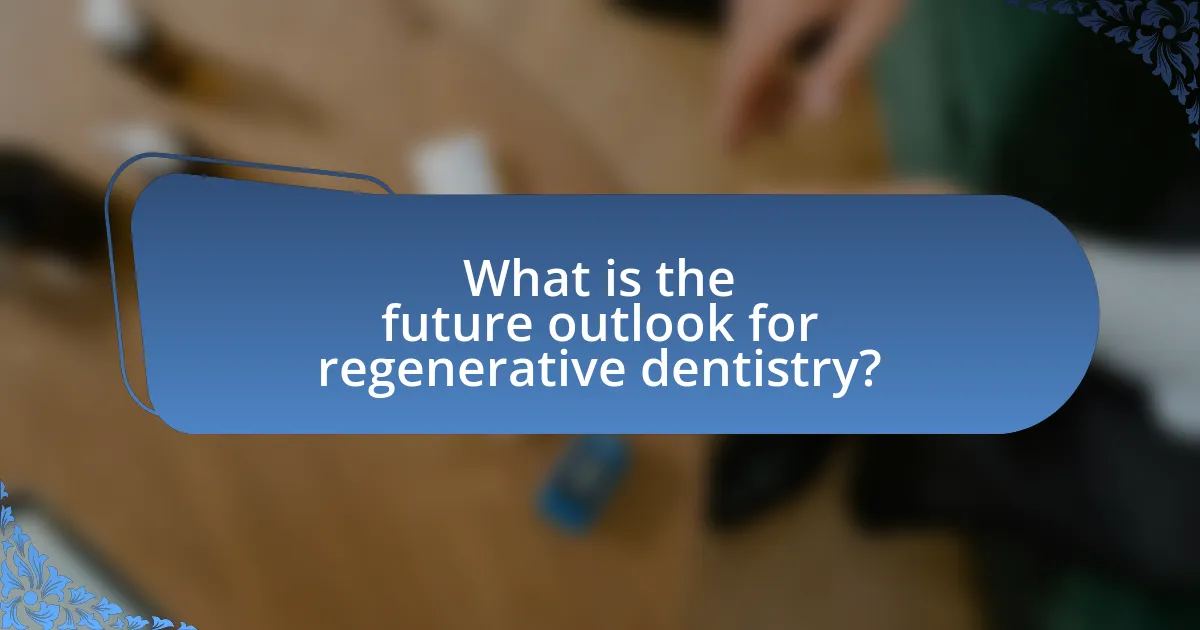
What is the future outlook for regenerative dentistry?
The future outlook for regenerative dentistry is promising, with advancements in stem cell research and tissue engineering poised to revolutionize dental treatments. Innovations in these fields are expected to enable the regeneration of dental tissues, such as enamel and dentin, potentially reducing the need for traditional restorative procedures. Research indicates that stem cells derived from dental pulp can differentiate into various cell types, facilitating the repair of damaged tissues. For instance, a study published in the journal “Stem Cells Translational Medicine” highlights the potential of dental pulp stem cells in regenerating pulp tissue, which could lead to more effective treatments for dental caries and pulpitis. As these technologies continue to evolve, regenerative dentistry is likely to enhance patient outcomes and transform the landscape of dental care.
What trends are emerging in regenerative dentistry research?
Emerging trends in regenerative dentistry research include the increased use of stem cells for dental tissue regeneration, advancements in 3D bioprinting technologies, and the exploration of biomaterials for enhanced healing. Research indicates that stem cells derived from dental pulp and periodontal tissues are being investigated for their potential to regenerate lost dental structures, as evidenced by studies showing successful regeneration of dentin and pulp tissues in animal models. Additionally, 3D bioprinting is gaining traction for creating complex tissue structures, allowing for precise placement of cells and biomaterials, which has been demonstrated in recent publications highlighting its application in creating scaffolds for dental tissue engineering. Furthermore, the development of novel biomaterials, such as hydrogels and bioactive glass, is being explored to improve the integration and healing of dental implants, supported by findings that show enhanced osteoconductivity and biocompatibility in clinical trials.
How might advancements in biotechnology influence dental practices?
Advancements in biotechnology are likely to significantly enhance dental practices through the integration of regenerative techniques, particularly stem cell therapy and tissue engineering. These innovations enable the regeneration of dental tissues, such as enamel and dentin, which can lead to improved treatment outcomes for conditions like caries and periodontal disease. For instance, research published in the journal “Nature Biotechnology” by authors including Zhang et al. (2020) demonstrates that stem cells derived from dental pulp can differentiate into various cell types necessary for tissue regeneration. This capability not only reduces the need for invasive procedures but also promotes natural healing processes, ultimately transforming how dental professionals approach restorative treatments.
What potential breakthroughs could reshape the future of dental care?
Potential breakthroughs that could reshape the future of dental care include advancements in stem cell therapy and tissue engineering. Stem cell therapy has the potential to regenerate dental tissues, such as enamel and dentin, which could eliminate the need for traditional fillings and crowns. Research published in the journal “Nature Biotechnology” by authors like Zhang et al. demonstrates that stem cells can differentiate into dental pulp cells, promoting the regeneration of damaged teeth. Additionally, tissue engineering techniques, such as 3D bioprinting, can create scaffolds that support the growth of new dental tissues, further enhancing restorative procedures. These innovations could lead to more effective, less invasive treatments in dentistry.
What practical steps can dental professionals take to integrate regenerative techniques?
Dental professionals can integrate regenerative techniques by adopting protocols that utilize stem cells and tissue engineering in clinical practice. This includes training in the extraction and application of stem cells from dental pulp, which has been shown to have regenerative properties. Additionally, professionals should implement biomaterials that support tissue regeneration, such as scaffolds that facilitate cell growth and differentiation. Research indicates that using these materials in conjunction with stem cell therapy can enhance healing outcomes, as demonstrated in studies published in the Journal of Dental Research, which highlight the effectiveness of these techniques in promoting tissue regeneration. Furthermore, dental professionals should collaborate with researchers to stay updated on advancements in regenerative dentistry, ensuring they apply the latest evidence-based practices in their treatments.
How can continuing education benefit practitioners in this field?
Continuing education benefits practitioners in regenerative dentistry by enhancing their knowledge of the latest advancements in stem cells and tissue engineering. This field is rapidly evolving, with new techniques and technologies emerging that can significantly improve patient outcomes. For instance, staying updated through workshops and courses allows practitioners to learn about innovative methods for tissue regeneration, which can lead to more effective treatments. Research indicates that practitioners who engage in ongoing education are better equipped to implement evidence-based practices, ultimately improving the quality of care they provide.
What resources are available for staying updated on regenerative dentistry advancements?
Key resources for staying updated on regenerative dentistry advancements include academic journals, professional organizations, and online platforms. Notable journals such as the Journal of Dental Research and Tissue Engineering provide peer-reviewed articles on the latest research and developments in the field. Professional organizations like the American Academy of Regenerative Dentistry offer newsletters and conferences that highlight cutting-edge advancements. Additionally, platforms like ResearchGate and PubMed allow access to a vast array of studies and publications, facilitating ongoing education and awareness of new techniques and technologies in regenerative dentistry.
